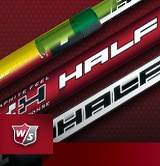In 1914, Wilson Sporting Goods Co. was founded in Chicago, and Wilson’s influence on the game of golf over the years is familiar to many of you: With the likes of Gene Sarazen, Sam Snead, and Arnold Palmer, Wilson’s Advisory Staff team is rich in tradition.
In the final round of the 1935 Masters, Gene Sarazen holed a 235-yard shot with a Wilson Staff 4-wood from the fairway on the par-5, 15th hole at Augusta for an albatross to tie Craig Wood, who he went on to beat in the 36-hole playoff. This famous victory made Sarazen the first golfer to have won all four Majors and complete the ‘Grand Slam’.
So what is Wilson Staff up to now? You may know about the recent success of Ricky Barnes and his return to the front pages; or Padraig Harrington’s 3 Major championship victories, which takes the total number of Majors won with Wilson Staff irons to 61. But what does this have to do with you and your game?
Behind the scenes is one of the strongest engineering teams in the world of sport. The popularity of Demarini baseball bats and Wilson tennis rackets far exceed that of golf clubs today; and you are more likely to buy a replica NFL football or NCAA basketball than the current line of golf balls. (Well, except for the SpongeBob golf ball. We sell more of those than tennis balls. I’m not kidding!) Nevertheless, the Golf R&D team, lead by Bob Thurman, has been hard at work.
To start, check out the online club fitting system at www.wilsonstaff.com. This is the only comprehensive tool that will help you select the model of iron that is best for you, (i.e. a traditional blade vs. a wide-soled distance iron) and then determine your 12-club set makeup between driver and putter using a series of questions about your game. In other words, you can figure out which loft hybrids and wedges you should have in your bag.
Looking back, several years ago Wilson introduced a wide tip iron shaft, the “Fat Shaft.” Simply put, the shaft works. Less twisting on off-center hits means longer and straighter shots. While the continued execution of this shaft was misguided, wide tip technology is alive and well in the new Di11 distance iron. With a much more versatile and visually appealing offering, the Di11 boasts the largest sweetspot in golf. Bob and his team consider this to be the area on the clubface in which the ball losses less than 5% of ball speed. The marketing team will offer you this tag line: Once you hit it, you get it. Padraig has been playing the 3-iron since the 2010 British Open.

However, this new incarnation of the Fat Shaft is not what the golf division is most excited about. It’s the Half + Half shaft, a half graphite, half steel iron and hybrid shaft. The design was inspired by Demarini baseball bats. Several years ago, Wilson’s engineers introduced a two-piece bat that was part aluminum and part carbon fiber. It provided an equipment solution that exceeded the performance of existing technology, and it changed the game. This year, the brand may surpass all expectations by not just climbing beyond Louisville Slugger in total bat sales, but also industry leader Easton.
Again, why should you care? The Half + Half golf shaft has the weight of a graphite shaft (76g in regular flex)—with the same vibration dampening in the handle—AND the control of steel. In fact, the bending properties of the shaft are that of a 100% steel shaft, and the torsional stability matches that of the—Fat Shaft! Thus, the ball goes longer. And it goes higher. And when you mishit the ball on the toe, the ball goes straighter. New for 2011, the shaft will be available in three flexes and it is offered in all of Wilson’s award-winning game-improvement iron models.
There is a caveat though. It is still most important to find the right shaft for you. Don’t be afraid to look toward a more flexible shaft. The ideal solution is the softest flex shaft that you can control. Do you still think that a soft shaft promotes a hook? That’s wrong! A shaft that is too whippy will lag through impact, promoting a high fade. Play a shaft that is too stiff and not only will you lose distance, but the shaft is prone to kick the clubface to square before the impact zone and cause a draw.
Ultimately, how you load and release the club will change very little, much like a finger print, and you should be open to a range of shaft solutions. For instance, my driver shaft is built (by GGG Inc. in La Quinta) to 248hz, a soft regular, while Wilson Advisory Staff member and Golf Tips Magazine Mental Game Editor, Rick Sessinghaus, uses a driver built to 285hz, which is XX-stiff!. We hit the ball the same distance, but with more consistency than we used to.
<p>&amp;amp;lt;p&amp;amp;gt;&amp;amp;amp;amp;lt;br /&amp;amp;amp;amp;gt; &amp;amp;lt;/p&amp;amp;gt;</p>
Of course, Haggin Oaks still has a full array of demo golf clubs and fitting tools to fit golfers of all abilities in the new Wilson Staff clubs including the new Staff D11 irons. For fitting appointments call 916.808.2531.



4 Comments